Making modern traditional onions
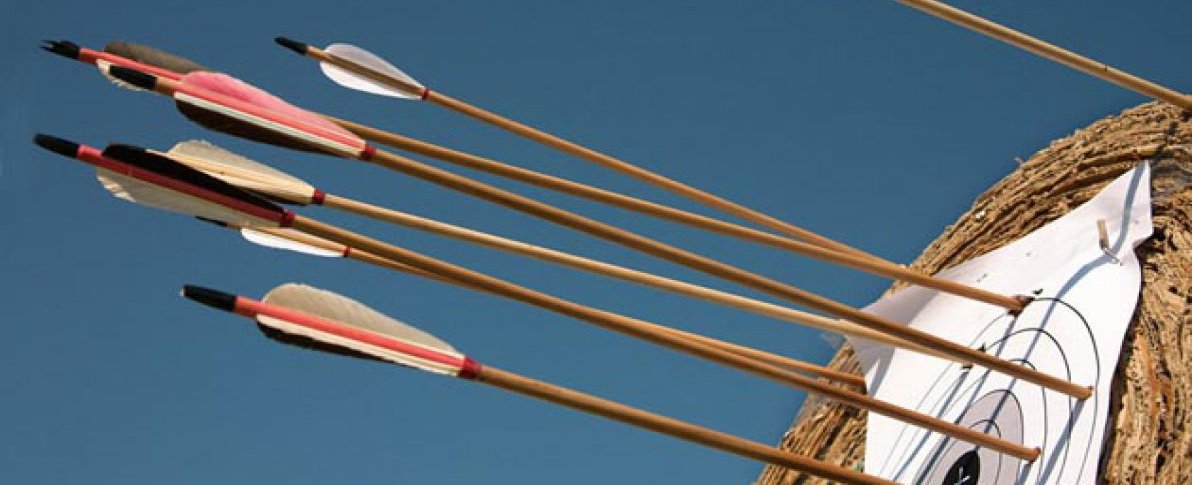
Let's try to describe such a field of activity as traditional bow-building. Consider the necessary knowledge, skills, technologies and tools necessary to create bows at the level of "advanced amateur".
This level was not chosen by chance - being here, we can already get a sufficiently high-quality product, without paying too much in terms of resources (money and time). Of course, “a little” is a relative concept. The pursuit of the ideal (in any field of activity) will require more and more investments, with less and less incremental results.
The presentation of the material I would like to start with a brief overview of traditional bows , then go to the basic knowledge, requirements for equipment, premises and in conclusion describe the technological process of manufacturing bows .
')
Within this article, other types of bows will not be considered: Olympic (sports “Olympic”) and block. Review on them is better to do in the form of individual publications.
Introduction
Traditional bows in the modern world are used in the field of recreation and entertainment, for shooting outdoors and indoors; as an element of historical reconstruction, in role movement; various sports shooting clubs are organized, respectively. tournaments; used for hunting and fishing.
The wide popularity of this type of activity contributes to the simplicity and accessibility of both the use and manufacture of bows; the absence of any special restrictions (physical, organizational, legislative); rich and extensive historical heritage of mankind in this field of activity.
Onions were always with a man in the war and during the extraction of food. And, only recently (by historical standards) has been ousted from use by more advanced types of weapons. Now, ray-shooting clubs exist in almost any more or less large city in the CIS countries, Europe, America, and Asia.
Modern traditional bows (if you do not take the historical reconstruction of natural materials) often only in form and form resemble their historical ancestors. New materials and technologies allow making bows more reliable, faster, more durable, and often with better performance characteristics.
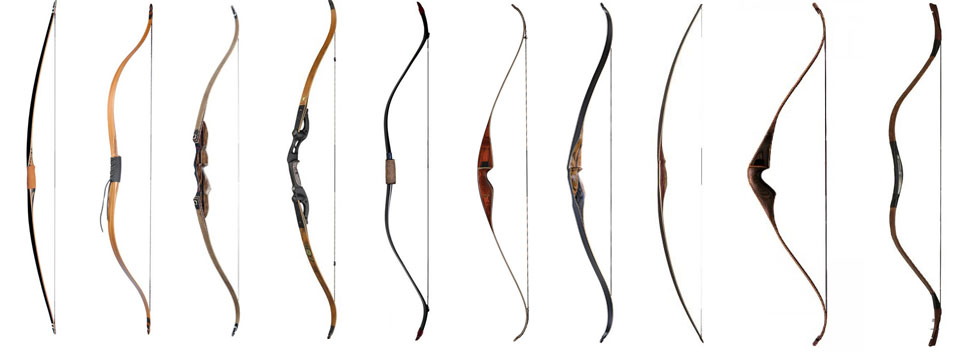
The variety of shapes and sizes of bows is very difficult to classify and structure. The set of input characteristics gives a huge number of forms and types of output.
Currently, the following bows are distinguished:
- in appearance - simple and complex;
- in the form of manufacture - straight, curved (open, compressed, closed, deep);
- on the material of manufacture - wooden, metal, fiberglass, combined;
- the location of the boom relative to the longitudinal axis - central, peripheral;
- on a design - continuous, folding;
- on application - for target shooting, for shooting at a distance, for hunting, for fishing, for leisure and entertainment;
- on the force of tension - from light to heavy, respectively;
- by appointment - men, women, children.
In the sphere of traditional bow production, the leading positions are now occupied by the countries of North America, Europe and Southeast Asia. Here are concentrated the main manufacturers and the main group of users, consumers of their products.
Internationalization has penetrated into this sphere of life. For example, in Europe, the traditional Japanese "Yumi" are produced, in China - the English longbow, in Hungary - the Mongolian horn bows. But, there is a certain link to the traditions of the region.
Let's try to detail the professional requirements for the master lukodelu. Let us highlight the knowledge and skills (necessary to create a bow) and the material and technical basis (required for the realization of existing ideas and ideas qualitatively, safely and in the shortest possible time).
Knowledge and skills
- Understanding the properties and characteristics of the basic materials used for the manufacture of onions: first of all it is wood (in all its variety of types and forms) and composite materials (fiberglass, textolites).
- Possession of woodworking technologies: sawing, gluing and polishing wood.
- Skills of working with adhesives: epoxy (hot and cold curing, of different thickness and viscosity), natural (for example, skin glue), polyvinyl acetate (PVA).
- Knowledge of design, composition, color, proportionality, aesthetics and beauty.
- Technology of finishing wooden products: varnishing, oil impregnation, polishing, painting, decorating.
Material and technical base
For the organization of the production of bows requires a separate room. The more it will be (within reasonable limits) - the better. It will be necessary to place and equip machines and equipment, work tables, to store blanks and materials for work.
In addition to the area, the main requirement for the room - the presence of ventilation. When processing wood (especially at the grinding stage) a lot of fine harmful dust is formed - it must be removed from the room in which people work.
From basic machines, we recommend universal grinding equipment and band saws (for straight and radius cuts). Circular saw (as opposed to a band saw) does not allow radius cuts.
A useful tool is to recommend a manual router (for making molds for gluing) and a grinding and polishing machine (for finishing).

Specialized devices will also be needed: for making bowstrings; for testing symmetry of bow flexion / extension; for measuring the tension force, the speed of the flight of the boom, etc.
Where to get materials?
Today there are so many ways to solve this issue: some of them independently harvest and dry wood, others buy ready-made gluing kits in online stores. As a rule, in most cases a compromise approach prevails - glue, fiberglass is bought; and blanks for the handle, veneer - are made independently.
Separately, I would like to dwell on a unidirectional fiberglass laminate . This is the main material that gives modern traditional bows all the characteristics that allow them to surpass their historical "ancestors".
 | 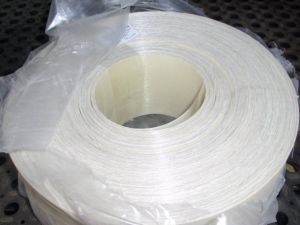 |
Fiberglass laminate is unidirectional and is produced by pulling glass wool, which is initially impregnated with a specially prepared epoxy binder. For lukostroeniya it has many advantages compared with other materials: wood, metal alloys.
The following characteristics are of fundamental importance:
- Low specific weight
- High wear resistance
- Large bending stress at failure
- High tensile strength
- Non-corrosive, aggressive substances, ambient temperature, non-toxic
- Ease of processing
- Excellent synthetic resin adhesion
In the shoulder of the bow unidirectional laminate is located in front and behind. Its properties make it possible to work effectively both in compression and in tension. The tree in the shoulder of a modern bow is used only for auxiliary, decorative purposes. The main load of energy storage takes on fiberglass.
Yes, animal tendons stretch better than glass yarns, and natural horn has greater compressive strength. But, these materials are not widely distributed, difficult to process, depend on humidity and temperature. From the natural materials onion shoulders can also be made from bamboo and sawn veneer hard wood.
List of blanks and materials for the assembly of onions:
- Handle - the central element that serves to hold it onions. The material of the handle must be strong and firm, well glued together and securely hold the fasteners. It is made of solid wood, it can be both homogeneous and composite.
- Wooden slats are thin strips of wood with polished surfaces, ready for gluing. The width of the slats should be equal to the width of the glass, handle and shape. Lamellas can be of constant thickness (parallel), and wedge - with a uniform change in thickness along the length. Typical wedge slats have a wedge shape from 1: 1000 to 1: 2000, i.e., the thickness varies by 1 or 2 mm by 1 meter length. Onions shoulders can contain both one, and several lamels - it depends on the form, length and the required force.
- Unidirectional fiberglass laminate - used for external lamination of bows. Usually one side is polished, the second (outer) side is smooth. Glass thickness can be 0.5 to 1.25 mm. Too thin glass places high demands on the homogeneity and straight lamination of the material of the lamellae, too thick - makes onion shoulders heavy and rigid.
- Wedges - inserts into the base of the shoulders collapsible bows. They make the shoulder in the attachment area rigid, and create a smooth transition from the handle to the flexible part of the shoulder.
- Glue - serves to securely connect all the details in the bow. It is recommended to use a two-component epoxy adhesive with a period of primary polymerization of at least 30 minutes - in order to have time to spread, soak, assemble and lay all the details in the form.
- Additional elements - lining the handle and the ends of the shoulders. You can use fiberglass, wood, textolite, glass fiber laminate of various colors and textures.
To process and shape the onion harvest, you will need the following:
- Form for gluing . If the bow is straight - the basis for the form can serve as a simple flat board. To manufacture a product with a complex curvilinear profile, it will be necessary to draw and create such a form from plywood or glued wood.

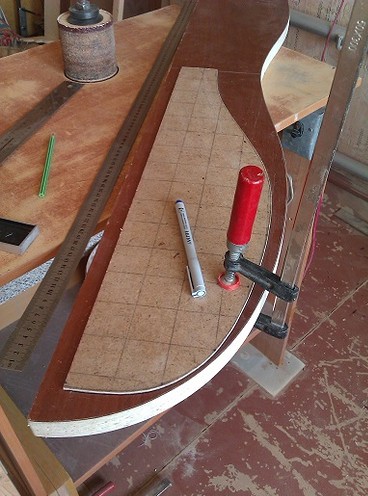
- Clamps . All onion components are glued under pressure. We need something this pressure on the workpiece to create. For high-quality gluing, it is necessary to provide a pressure of at least 2 kg / cm ^ 2, when gluing together with an area of 4.5x180 cm, this will be more than 800 kg. There are several solutions to this issue:
- Manual mechanical clamps
- Pneumatic hose with a chamber (creating pressure with compressed air)
- Winding with rope or rubber band.
- Tool for processing . As stated above - requires a small fleet of machinery. Manual mechanical processing is possible, but it is very laborious and time consuming (and the result is usually of poor quality). What exactly to choose, what is available - it is necessary to look individually. To the necessary minimum should be attributed belt grinder and a circular or band saw on wood.
Units, standards
The English numeral system of physical quantities prevails in the world of bows. Inches and feet are used to denote length, and pounds in weight. It happened historically. In the description of the concrete bows you will find something like this: type: “modern longbow”, length: 68 inches, tension force: 45 pounds. The brain gets used and, over time, is rebuilt for quick perception and conversion of these values into meters and kilograms we are used to.
Manufacturing process
The technology is more or less standardized, the differences (from master to master) are in the available machine park, available technologies and materials. As an example, will be described the steps of manufacturing fiberglass composite onions .
1. Select the type of onions. It is selected individually based on the tastes and preferences of the master.
2. The maximum detailing of all parameters, the elaboration of documentation and the study of the experience of predecessors. We estimate the need for materials, details, make sketches and draft-clean sketches. Gradually we get a complete finishing technical solution (on paper or in the CAD-system).
3. We make the basic form for gluing onions. It can be made of plywood. Also cut out the blank for the handle.
4. In parallel, we order (or we make ourselves) veneer sawn for onion shoulders, epoxy glue, unidirectional fiberglass laminate.

5. Glue all the parts together: produce compression of all layers together in the form under pressure.
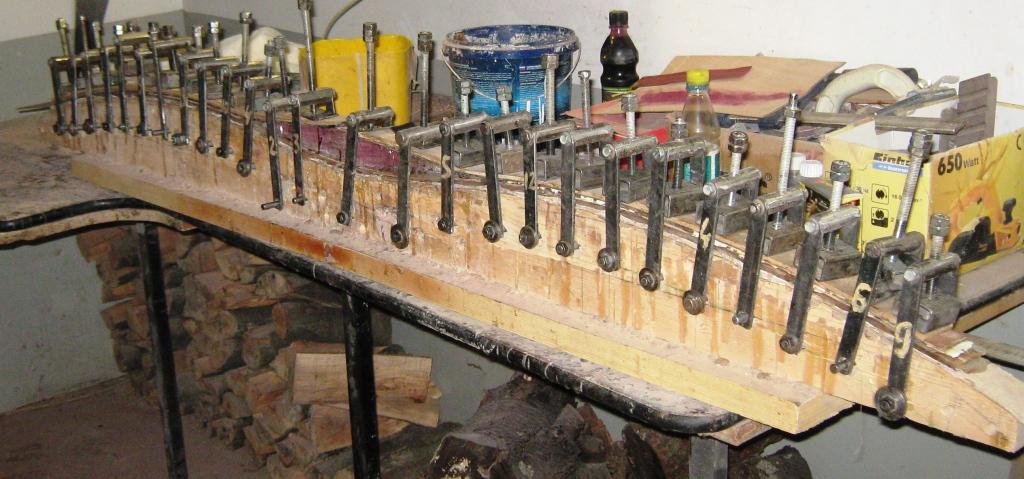
6. Cutting, half-rough grinding, cutting through the grooves under the string, setting the temporary string, tyling (giving the shoulders symmetry of the bow when bent).
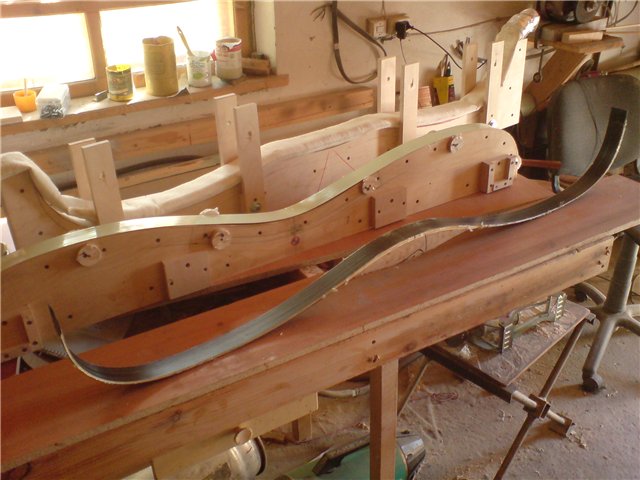
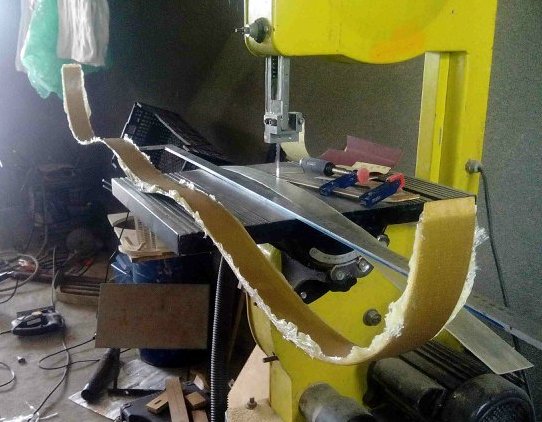
7. Fine finish. Surfaces are successively processed with smaller and smaller abrasives. Grinding materials with less and less grit are used. For example: sanding discs with grain 60, 80, 120, 240, 400, 600, 1000 and 1500 grit.
The smaller the step and the finer the final grain, the better the processing result. After each layer, I recommend raising the pile of wood by wiping the surface with a wet sponge.
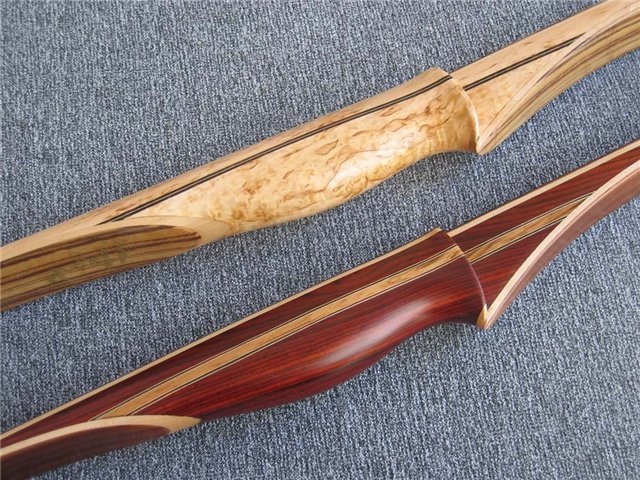
8. Weave a bowstring for onions in a special device.
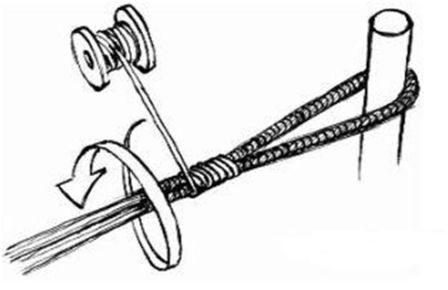
9. Measure the resulting tension force. We make test shooting of bows (arrow speed, range, accuracy, vibrations).
10. We sew a cover for onions, we trim the handle with leather.
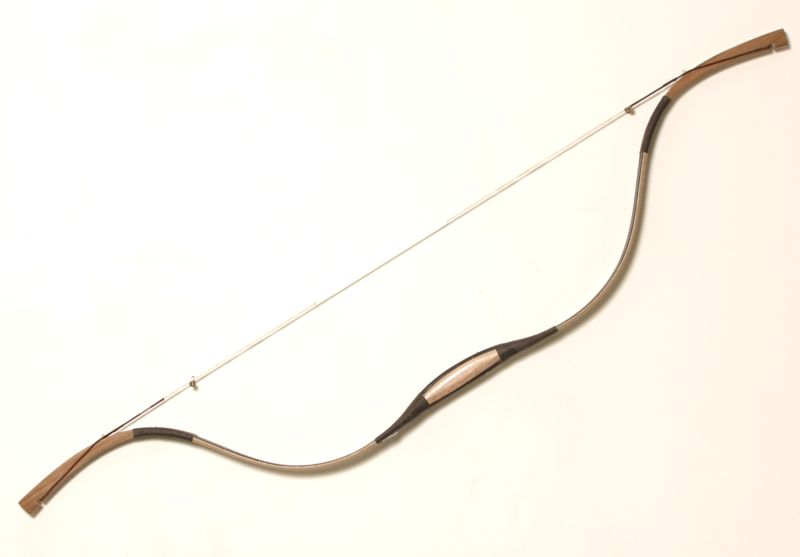
According to calendar dates: in the hobby mode, and with basic skills, all these stages can be completed in about six months.
Analysis of the results
The evaluation of the characteristics of the resulting product can be divided into subjective and objective.
Subjectively evaluated the type, color, shape, finish and paint onions. These are personal characteristics, they differ in different people.
The objective characteristics include the efficiency of the bow (measuring the potential energy stored in the shoulders of the bow when pulling the string and the kinetic energy transmitted to the arrow when fired). The efficiency of modern fiberglass bows is quite high: it reaches, on average, 75-85%.
For a visual assessment of the stored energy, you can build a graph of the dependence of the tension force on the length of the stretch. The shaded area is a visual expression of stored energy. The section AD with a length of 0.6 meters is the length of the bowstring, and the segment BC is an increase in the tension force from the initial (approximately 200 Newton) to the final (350 Newton, from 20 to 35 kg).

Also to the objective characteristics you can add the speed of the arrow, the tension force, weight, length, the maximum possible length of the stretch and the overall reliability of the bow (guaranteed number of shots before breakage).
The legislative framework
The upper limit of the bow tension force is limited. The specific figure is different in different countries.
For example, for Russia, the tension force of a bowstring of a bow should be no more than 27 kgf, For Ukraine, no more than 20 kgf. Based on this, we can assume that bows with a lower tension force do not belong to combat throwing weapons, but are equated with sports equipment that do not require any special permission to acquire, manufacture and use.
In more detail, you can (and should, by and large!) Consult with lawyers in your country of residence.
Conclusion
Successful shooting and do not forget about security measures!

Source: https://habr.com/ru/post/371097/
All Articles